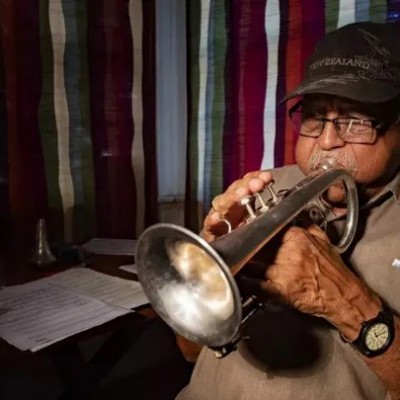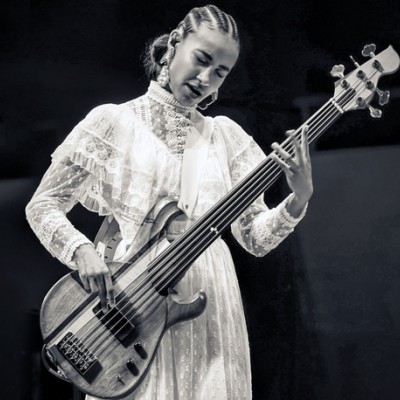Oct 28, 2025 10:47 AM
In Memoriam: Jack DeJohnette, 1942–2025
Jack DeJohnette, a bold and resourceful drummer and NEA Jazz Master who forged a unique vocabulary on the kit over his…

Aly Keita (left), Jan Galega Brönnimann and Lucas Niggli perform at London’s Vortex Jazz Club on April 17.
(Photo: Inès Elsa Dalal)Following the exceptional opening night performance by bassist Barry Guy, the Intakt Records season at London’s Vortex Jazz Club continued, presenting multiple acts every evening during the glorious 12-day event in April, with numerous highlights from the esteemed artists on the Swiss label’s roster.
Saxophonist Trevor Watts made his name in London’s improvising scene, etching out his reputation in the late 1960s. Here at the Vortex, in a duo with Swiss drummer Dieter Ulrich (on April 17), Watts operated with a harsh, strident attack on alto, keening and direct. Ulrich is more of a conventional drummer, when compared to the previous evening’s abstract display by Lucas Niggli.
Following a short introductory piece, Watts switched to soprano, adopting a sparser approach of cutting, curtailed blasts. The pair don’t really step sideways from what the audience might expect, until a return to alto on the final piece produced a gutsier unpredictability, as Ulrich picked up a muted, sawn-off bugle.
Next came another one of the season’s most gripping sets, completely featuring a West African pulse. Musicians Aly Keita (playing the balafon, a Malian marimba precursor, with gourd resonators placed underneath each wooden key-strip), Jan Galega Brönnimann (bass clarinets) and Lucas Niggli (drums) concentrated on the most heightened form of groove, enriched by an immense force of musical optimism.
Keita’s speeding technique provided a strong rhythmic element, in addition to his melodic rippling. Brönnimann’s heavily electrified bass clarinet also mingled rhythmic weight with excursions into growling freedom, but he held his ultimate weapon in reserve, eventually blowing stacks on the contrabass clarinet. As if this wasn’t sufficient, he also had this monster hooked up to a volume-hiking wah-wah pedal, belching colossally. At this point, Keita picked up a small mbira (thumb piano), creating one of the most unusual instrumental combinations possible.
Niggli revealed his equal prowess as a heavy rhythm machine, operating in the Tony Allen Afro-beat zone, pausing only to chime around a spread of small gongs, laid out on his skins. For most of the time, this trio locked into a majestic, hurtling pulse, with free-form clarinet outbursts soaring over the top.
“Mama Bamako” provided an oasis of calm, before Watts returned at encore-time, soloing on alto, and easily surmounting his playing during his own set, swaggering beside the contrabass clarinet, as Keita added vocals to the brew.
The Swiss pianist Irène Schweizer and South African drummer Louis Moholo-Moholo played an important part in the history of Intakt, with their 1986 album arriving early in the label’s discography. At Vortex (on April 18), Schweizer displayed the speed and accuracy of a Conlon Nancarrow piano roll, but slivered with boogie-woogie hints, while Moholo scuttled constantly.
Snatches of township groove passed by, Moholo leading with a solo, before Schweizer sprayed shrapnel across the stage, then delivered a delicate series of karate chops with her left hand. Their set revealed the risks involved with improvisation: Sometimes the pieces were so short it sounded like this might not be deliberate, as if they might be running out of steam. Or perhaps the pair preferred a palate-clearing respite, but ultimately, Moholo just didn’t appear to be in a productive mood.
When saxophonist Omri Ziegele joined them for the second set, he instantly imposed more structure, leading with his own compositions. Curiously, this freed up Moholo to be more expressive. He seemed happy to exist in a drum universe of his own creation, freed of rhythmic responsibility. Ziegele progressed further into free bleating, leading to a saxophone/drum section, his high-wire alto squealing up to the ceiling.
Trevor Watts (left) and Dieter Ulrich perform at London’s Vortex Jazz Club on April 17. (Photo: Inès Elsa Dalal)
On April 20, German pianist Alexander von Schlippenbach began the evening with a solo set, using the tunes of Thelonious Monk as a foundation. He wanted to make clear that some of his own works would be included, and sometimes these sounded so closely mixed with the Monk-fishing stream that the perimeters became fluid.
He made bold clusters and atonal jabs, alternated with elaborate runs and dogged repeats. At times, the variations were extreme, but then he occasionally alighted on a theme, playing it quite straight, with a walking bass line, continuing via a swap to the right hand, travelling higher and higher. Palms suspended high above the keys, he dangled straightened fingers downward, swiping and clawing. Schlippenbach is one of those players who grumbles along vocally, approximating the tune in hand, mostly to distracting effect. Still, the audience sat in absolutely silent, appreciative concentration.
(To read a review of Barry Guy’s performance at the Vortex on April 16, click here.) DB

Jack DeJohnette boasted a musical resume that was as long as it was fearsome.
Oct 28, 2025 10:47 AM
Jack DeJohnette, a bold and resourceful drummer and NEA Jazz Master who forged a unique vocabulary on the kit over his…

“Think of all the creative people I’m going to meet and a whole other way of thinking about music and a challenge of singing completely different material than I would have sung otherwise to my highest level in dedication to the moment,” Elling says about his Broadway run.
Sep 9, 2025 1:18 PM
Kurt Elling was back at home in Chicago, grabbing some family time in a late-June window between gigs. Sporting a smile…

Pat Metheny will perform with his Side-Eye III ensemble at Big Ears 2026 in Knoxville, Tennessee, next March.
Sep 9, 2025 12:19 PM
Big Ears has announced the lineup for its 2026 festival, which will take place March 26–29 and include 250…

“[That’s] the thing of the beboppers,” Bradford said. “These guys were important for not only playing that wonderful music, but they knew a sort of social stance, you see?”
Sep 9, 2025 1:07 PM
It was a calm, balmy, near-perfect evening in Westwood, California, not far from UCLA, in the expansive courtyard at…

Esperanza Spalding closed an audacious Chicago Jazz Festival set with “Endangered Species.”
Sep 9, 2025 11:50 AM
The 45th Chicago Jazz Festival kicked off its headline events with two erudite individuals, Esperanza Spalding and…